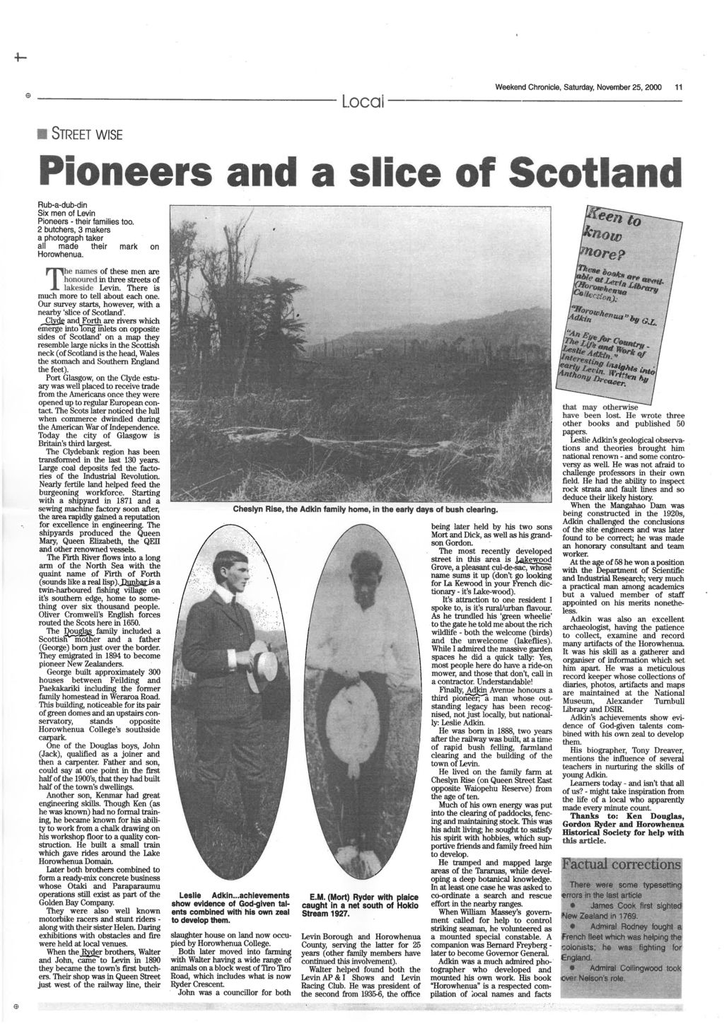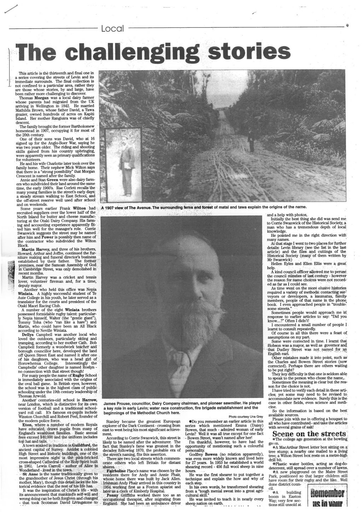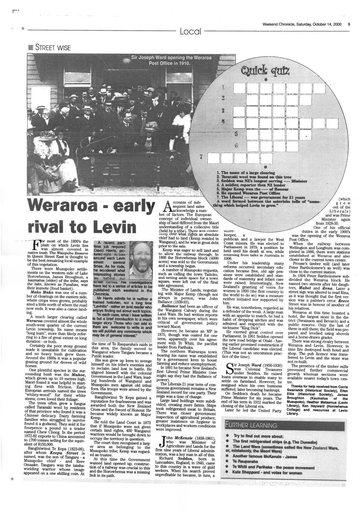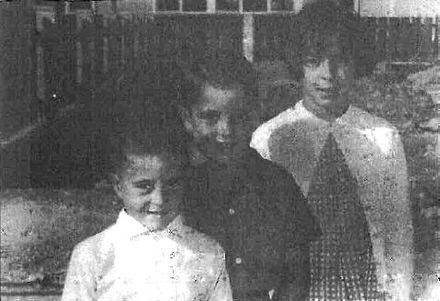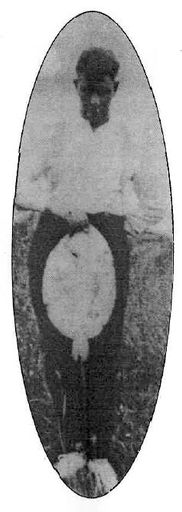Pioneers and a slice of Scotland
- Description
Photo at left: Cheslyn Rise, the Adkin family home, in the early days of bush clearing.
Pioneers and a slice of Scotland
Rub-a-dub-din
Six men of Levin
Pioneers - their families too.
2 butchers, 3 makers
a photograph taker
all made their mark on Horowhenua.The names of these men are honoured in three streets of lakeside Levin. There is much more to tell about each one. Our survey starts, however, with a nearby `slice of Scotland'.
Clyde and Forth are rivers which emerge into long-inlets on opposite sides of Scotland on a map they resemble large nicks in the Scottish neck (of Scotland is the head, Wales the stomach and Southern England the feet).
Port Glasgow, on the Clyde estuary was well placed to receive trade from the Americans once they were opened up to regular European con-tact. The Scots later noticed the lull when commerce dwindled during the American War of Independence. Today the city of Glasgow is Britain's third largest.
The Clydebank region has been transformed in the last 130 years. Large coal deposits fed the factories of the Industrial Revolution. Nearly fertile land helped feed the burgeoning workforce. Starting with a shipyard in 1871 and a sewing machine factory soon after, the area rapidly gained a reputation for excellence in engineering. The shipyards produced the Queen Mary, Queen Elizabeth, the QEII and other renowned vessels.
The Firth River flows into a long arm of the North Sea with the quaint name of Firth of Forth (sounds like a real lisp). Dunbar is a twin-harboured fishing village on it's southern edge, home to some-thing over six thousand people. Oliver Cromwell's English forces routed the Scots here in 1650.
The Dougas family included a Scottish mother and a father (George) born just over the border. They emigrated in 1894 to become pioneer New Zealanders. George built approximately 300 houses between Feinlding and Paekakariki including the former family homestead in Weraroa Road. This building, noticeable for its pair of green domes and an upstairs conservatory, stands opposite Horowhenua College's southside carpark.
One of the Douglas boys, John (Jack), qualified as a joiner and then a carpenter. Father and son, could say at one point in the first half of the 1900's, that they had built half of the town's dwellings. Another son, Kenmar had great engineering skills. Though Ken (as he was known) had no formal training, he became known for his ability to work from a chalk drawing on his workshop floor to a quality construction. He built a small train which gave rides around the Lake Horowhenua Domain.
Later both brothers combined to form a ready-mix concrete business whose Otaki and Paraparaumu operations still exist as part of the Golden Bay Company. They were also well known motorbike racers and stunt riders - along with their sister Helen. Daring exhibitions with obstacles and fire were held at local venues.
When the Ryder brothers, Walter and John, came to Levin in 1890 they became the town's first butchers. Their shop was in Queen Street just west of the railway line, their slaughter hgouse on land now occupied by Horowhenua College.
Photo at left: Leslie Adkin...achievements show evidence of God-given tal-ents combined with his own zeal to develop them.
Both later moved into farming with Walter having a wide range of animals on a block west of Tiro Tiro Road, which includes what is now Ryder Crescent. John was a councillor for both Levin Borough and Horowhenua County serving the latter for 25 years (other family members have continued this involvement).
Photo at left: E.M. (Mort) Ryder with plaice caught in a net south of Hokio Stream 1927.
Walter helped found both the Levin AP & I Shows and Levin Racing Club. He was president of the second from 1935-6, the office being later held by his two sons Mort and Dick, as well as his grand-son Gordon. The most recently developed street in this area is Lakewood Grove, a pleasant cul-de-sac, whose name sums it up (don't go looking for La Kewood in your French dictionary - it's Lake-wood).
It's attraction to one resident I spoke to, is it's rural/urban flavour. As he trundled his 'green wheelie' to the gate he told me about the rich wildlife - both the welcome (birds) and the unwelcome (lakeflies). While I admired the massive garden spaces he did a quick tally: Yes, most people here do have a ride-on mower, and those that don't, call in a contractor. Understandable! Finally, Adkin Avenue honours a third pioneer; a man whose out-standing legacy has been recognised, not just locally, but nationally: Leslie Adkin. He was born in 1888, two years after the railway was built, at a time of rapid bush felling, farmland clearing and the building of the town of Levin. He lived on the family farm at Cheslyn Rise (on Queen Street East opposite Waiopehu Reserve) from the age of ten. Much of his own energy was put into the clearing of paddocks, fencing and maintaining stock This was his adult living; he sought to satisfy his spirit with hobbies, which supportive friends and family freed him to develop. He tramped and mapped large areas of the Tararuas, while developing a deep botanical knowledge. In at least one case he was asked to co-ordinate a search and rescue effort in the nearby ranges. When William Massey's government called for help to control striking seaman, he volunteered as a mounted special constable. A companion was Bernard Freyberg - later to become Governor General. Adkin was a much admired photographer who developed and mounted his own work. His book "Horowhenua" is a respected compilation of local names and facts that may otherwise have been lost. He wrote three other books and published 50 papers. Leslie Adkin's geological observations and theories brought him national renown - and some controversy as well. He was not afraid to challenge professors in their own field. He had the ability to inspect rock strata and fault lines and so deduce their likely history When the Mangahao Dam was being constructed in the 1920s, Adkin challenged the conclusions of the site engineers and was later found to be correct; he was made an honorary consultant and team worker. At the age of 58 he won a position with the Department of Scientific and Industrial Research; very much a practical man among academics but a valued member of staff appointed on his merits nonetheless. Adkin was also an excellent archaeologist, having the patience to collect, examine and record many artifacts of the Horowhenua. It was his skill as a gatherer and organiser of information which set him apart. He was a meticulous record keeper whose collections of diaries, photos, artifacts and maps are maintained at the National Museum, Alexander Turnbull Library and DSIR. Adkin's achievements show evidence of God-given talents combined with his own zeal to develop them. His biographer, Tony Dreaver, mentions the influence of several teachers in nurturing the skills of young Adkin. Learners today - and isn't that all of us? - might take inspiration from the life of a local who apparently made every minute count. Thanks to: Ken Douglas, Gordon Ryder and Horowhenua Historical Society for help with this article.
Factual corrections
There were some typesetting errors in the last article:
· James Cook first sighted New Zealand in 1769.
· Admiral Rodney fought a French fleet which was helping the colonists; he was fighting for England.
· Admiral Collingwood took over Nelson's role.
Identification
- Date
- November 25, 2000
Taxonomy
- Community Tags

